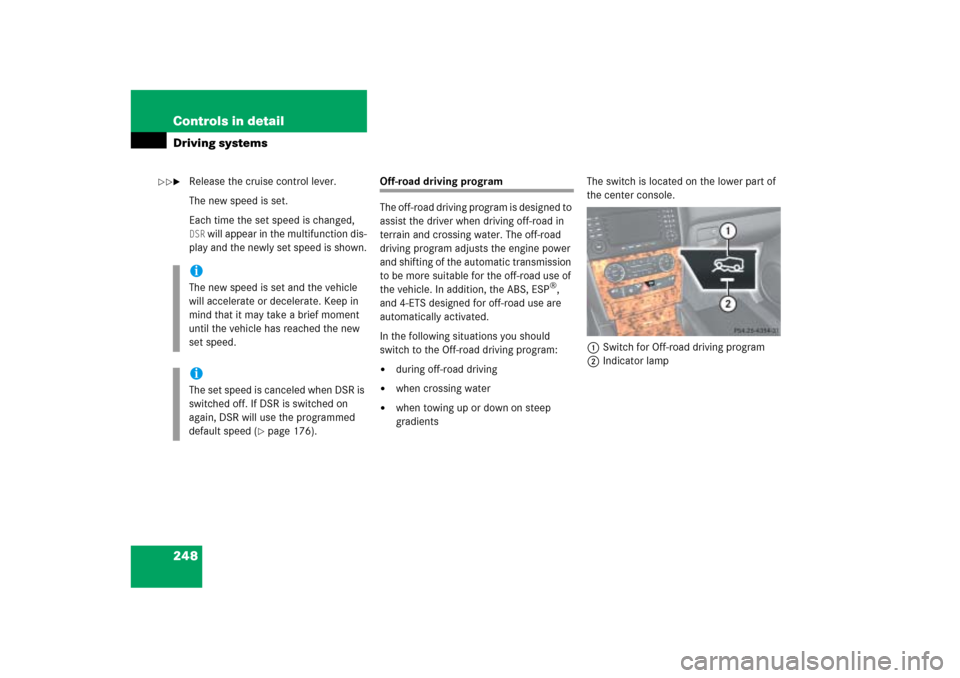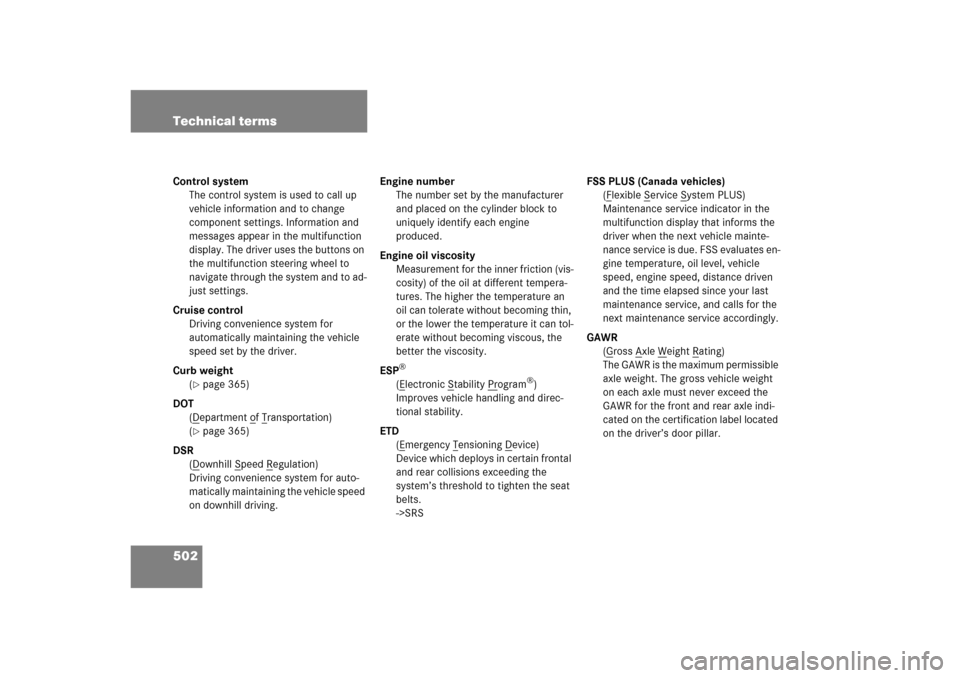Page 244 of 539

243 Controls in detail
Driving systems
�
Briefly press the cruise control lever
down past the resistance point in direc-
tion of arrow2 (
�page 239).
The vehicle speed decreases in incre-
ments of 5 mph (Canada: 10 km/h).Setting to last stored speed
(“Resume” function)
�
Briefly pull the cruise control lever in di-
rection of arrow4 (
�page 239).
The cruise control resumes the last set
speed.
�
Remove your foot from the accelerator
pedal.
The last set speed appears in the multi-
function display for approximately five sec-
onds.
Downhill Speed Regulation (DSR)
iThe new speed is set and the vehicle
will decelerate. Keep in mind that it
may take a brief moment until the vehi-
cle has reached the set speed.
Warning!
G
The speed stored in memory should only be
set again if prevailing road conditions per-
mit. Possible acceleration or deceleration
differences arising from returning to the pre-
set speed could cause an accident and/or
serious injury to you and others.
Warning!
G
Downhill Speed Regulation is a convenience
system designed to assist the driver during
vehicle operation. The system must be set
to be appropriate for the topographical and
weather conditions encountered which can
change quickly. The driver is and must
remain at all times responsible for the vehi-
cle speed and for safe brake operation.
Depending on the programmed speed
(�page 176), actual vehicle speed and gra-
dient, switching on the DSR while driving
can cause the vehicle to slow down rapidly
and you may hear a sound which is caused
by the activation of the vehicle’s brake sys-
tem through the DSR. Sudden and unex-
pected decelaration can result in loss of
vehicle control, causing an accident and/or
serious personal injury to you and others.
Do not switch on the DSR in a circumstance
where rapid decelaration could result in a
loss of vehicle control.
Page 245 of 539

244 Controls in detailDriving systemsFor more information, see “Off-road driv-
ing” (
�page 306).
The DSR is an aid for driving downhill. DSR
regulates your vehicle’s speed when driv-
ing downhill to the value set in the control
system (�page 176). The steeper the
downhill gradient is, the greater the brake
application. On flat road surfaces, DSR
brakes only slightly or not at all.
DSR regulates the vehicle’s speed in auto-
matic transmission positionsD, orR.
You can drive slower or faster than the set
speed at any time by braking the vehicle or
depressing the accelerator pedal.
iWhenever DSR is switched on, DSR will
use the programmed default speed to
regulate the vehicle’s speed. The de-
fault speed programmed at the factory
is 4 mph (Canada: 6 km / h). The de-
fault speed can be reprogrammed us-
ing the control system (
�page 176).
The next time DSR is switched on, DSR
will use the newly programmed default
speed to regulate the vehicle’s speed.
Once DSR is switched on, you can ad-
just the set speed using the cruise con-
trol lever (
�page 238). Keep in mind
that adjusting the set speed using the
cruise control lever with DSR switched
on will not change the programmed de-
fault speed. If DSR is switched off and
then switched on again, DSR will use
the programmed default speed.
Whenever the DSR is switched on, the
programmed default speed will be
used. That value can be changed
through the multifunction display. The
next time the DSR is switched on, it will
use that newly programmed default
speed.
Depending on the road surface and lev-
el of downhill grade, the DSR may not
be able to maintain the set speed. To
maintain the set speed, apply the
brakes if necessary.
Page 248 of 539

247 Controls in detail
Driving systems
You can increase or reduce the set speed
in two stages.
Adjustment in 1 mph (Canada: 1 km/h)
increments
Increase set speed:�
Lift the cruise control lever to the resis-
tance point in direction of arrow1
(�page 246) and hold it up until the
desired speed is reached.
�
Release the cruise control lever.Reduce set speed:
�
Press the cruise control lever to the re-
sistance point in direction of arrow2
(�page 246) and hold it down until the
desired speed is reached.
�
Release the cruise control lever.
The new speed is set.
Each time the set speed is changed, DSR
will appear in the multifunction dis-
play and the changed set speed is
shown.Adjustment in 5 mph
(Canada: 10 km/h) increments
Increase set speed:
�
Briefly lift the cruise control lever up
past the resistance point in direction of
arrow1 (
�page 246).
�
Release the cruise control lever.
Reduce set speed:
�
Briefly press the cruise control lever
down past the resistance point in direc-
tion of arrow2 (
�page 246).
iThe set value is increased in 1 mph
(Canada: 1 km/h) increments each
time you lift or depress the cruise con-
trol lever to the resistance point.
iThe set speed is canceled when DSR is
switched off. If DSR is switched on
again, DSR will use the programmed
default speed (
�page 176).
iThe set speed is increased in 5 mph
(Canada: 10 km/h) increments each
time you lift or depress the cruise con-
trol lever past the resistance point.
��
Page 249 of 539

248 Controls in detailDriving systems�
Release the cruise control lever.
The new speed is set.
Each time the set speed is changed, DSR
will appear in the multifunction dis-
play and the newly set speed is shown.
Off-road driving program
The off-road driving program is designed to
assist the driver when driving off-road in
terrain and crossing water. The off-road
driving program adjusts the engine power
and shifting of the automatic transmission
to be more suitable for the off-road use of
the vehicle. In addition, the ABS, ESP
®,
and 4-ETS designed for off-road use are
automatically activated.
In the following situations you should
switch to the Off-road driving program:
�
during off-road driving
�
when crossing water
�
when towing up or down on steep
gradientsThe switch is located on the lower part of
the center console.
1Switch for Off-road driving program
2Indicator lamp
iThe new speed is set and the vehicle
will accelerate or decelerate. Keep in
mind that it may take a brief moment
until the vehicle has reached the new
set speed.iThe set speed is canceled when DSR is
switched off. If DSR is switched on
again, DSR will use the programmed
default speed (
�page 176).
��
Page 503 of 539

502 Technical termsControl system
The control system is used to call up
vehicle information and to change
component settings. Information and
messages appear in the multifunction
display. The driver uses the buttons on
the multifunction steering wheel to
navigate through the system and to ad-
just settings.
Cruise control
Driving convenience system for
automatically maintaining the vehicle
speed set by the driver.
Curb weight
(
�page 365)
DOT
(Department o
f Transportation)
(
�page 365)
DSR
(Downhill S
peed R
egulation)
Driving convenience system for auto-
matically maintaining the vehicle speed
on downhill driving.Engine number
The number set by the manufacturer
and placed on the cylinder block to
uniquely identify each engine
produced.
Engine oil viscosity
Measurement for the inner friction (vis-
cosity) of the oil at different tempera-
tures. The higher the temperature an
oil can tolerate without becoming thin,
or the lower the temperature it can tol-
erate without becoming viscous, the
better the viscosity.
ESP
®(Electronic S
tability Pr
ogram
®)
Improves vehicle handling and direc-
tional stability.
ETD
(E
mergency T
ensioning D
evice)
Device which deploys in certain frontal
and rear collisions exceeding the
system’s threshold to tighten the seat
belts.
->SRSFSS PLUS (Canada vehicles)
(F
lexible S
ervice S
ystem PLUS)
Maintenance service indicator in the
multifunction display that informs the
driver when the next vehicle mainte-
nance service is due. FSS evaluates en-
gine temperature, oil level, vehicle
speed, engine speed, distance driven
and the time elapsed since your last
maintenance service, and calls for the
next maintenance service accordingly.
GAWR
(G
ross A
xle W
eight R
ating)
The GAWR is the maximum permissible
axle weight. The gross vehicle weight
on each axle must never exceed the
GAWR for the front and rear axle indi-
cated on the certification label located
on the driver’s door pillar.